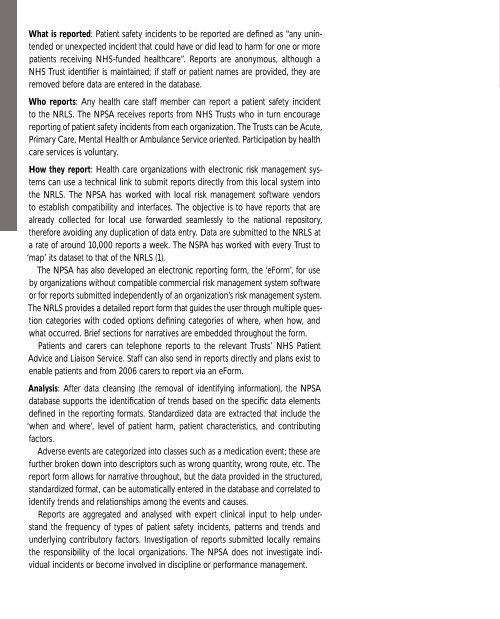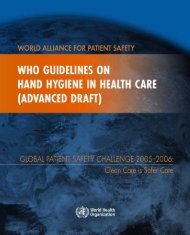Adverse event reporting.pdf
Adverse event reporting.pdf
Adverse event reporting.pdf
Create successful ePaper yourself
Turn your PDF publications into a flip-book with our unique Google optimized e-Paper software.
What is reported: Patient safety incidents to be reported are defined as “any unintended<br />
or unexpected incident that could have or did lead to harm for one or more<br />
patients receiving NHS-funded healthcare”. Reports are anonymous, although a<br />
NHS Trust identifier is maintained; if staff or patient names are provided, they are<br />
removed before data are entered in the database.<br />
Who reports: Any health care staff member can report a patient safety incident<br />
to the NRLS. The NPSA receives reports from NHS Trusts who in turn encourage<br />
<strong>reporting</strong> of patient safety incidents from each organization. The Trusts can be Acute,<br />
Primary Care, Mental Health or Ambulance Service oriented. Participation by health<br />
care services is voluntary.<br />
How they report: Health care organizations with electronic risk management systems<br />
can use a technical link to submit reports directly from this local system into<br />
the NRLS. The NPSA has worked with local risk management software vendors<br />
to establish compatibility and interfaces. The objective is to have reports that are<br />
already collected for local use forwarded seamlessly to the national repository,<br />
therefore avoiding any duplication of data entry. Data are submitted to the NRLS at<br />
a rate of around 10,000 reports a week. The NSPA has worked with every Trust to<br />
‘map’ its dataset to that of the NRLS (1).<br />
The NPSA has also developed an electronic <strong>reporting</strong> form, the ‘eForm’, for use<br />
by organizations without compatible commercial risk management system software<br />
or for reports submitted independently of an organization’s risk management system.<br />
The NRLS provides a detailed report form that guides the user through multiple question<br />
categories with coded options defining categories of where, when how, and<br />
what occurred. Brief sections for narratives are embedded throughout the form.<br />
Patients and carers can telephone reports to the relevant Trusts’ NHS Patient<br />
Advice and Liaison Service. Staff can also send in reports directly and plans exist to<br />
enable patients and from 2006 carers to report via an eForm.<br />
Analysis: After data cleansing (the removal of identifying information), the NPSA<br />
database supports the identification of trends based on the specific data elements<br />
defined in the <strong>reporting</strong> formats. Standardized data are extracted that include the<br />
‘when and where’, level of patient harm, patient characteristics, and contributing<br />
factors.<br />
<strong>Adverse</strong> <strong>event</strong>s are categorized into classes such as a medication <strong>event</strong>; these are<br />
further broken down into descriptors such as wrong quantity, wrong route, etc. The<br />
report form allows for narrative throughout, but the data provided in the structured,<br />
standardized format, can be automatically entered in the database and correlated to<br />
identify trends and relationships among the <strong>event</strong>s and causes.<br />
Reports are aggregated and analysed with expert clinical input to help understand<br />
the frequency of types of patient safety incidents, patterns and trends and<br />
underlying contributory factors. Investigation of reports submitted locally remains<br />
the responsibility of the local organizations. The NPSA does not investigate individual<br />
incidents or become involved in discipline or performance management.
















